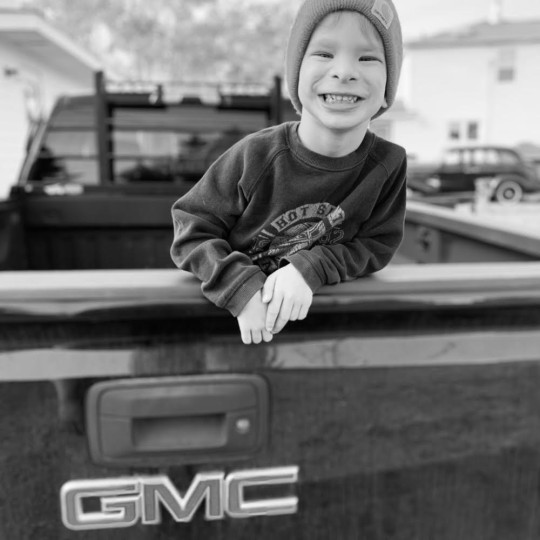“Dominic was an interesting newborn and infant, it seemed we were in a world of our own because no parenting book, website or Instagram page seemed relatable,” says Katrina Cooper-Boudreau. “Things were different for us, we knew that, but didn't know why.”
A complicated and painful pregnancy led doctors to admit Cooper-Boudreau to the IWK at 34 weeks. On the morning of week 35 Dominic was born via c-section. He weighed 1730 grams and was immediately taken to the neonatal intensive care unit (NICU), where the family would spend the next three weeks.
“At this point we were unaware of Dominic's genetic condition,” says Cooper-Boudreau. “All we knew was that he was premature, small, adorable and feisty.”
Being both premature and an intrauterine growth restriction (IUGR) baby it was understandable that Dominic’s milestones were late. The family focused on physical and occupational therapy to get his legs crawling and walking. They were referred to Hearing and Speech Nova Scotia to motivate his speech.
“In the meantime, we started using sign language with him, and he caught on fast and had well over 150 signs when I stopped keeping track,” says Cooper-Boudreau. “He would tell us full stories and even have dreams in sign.”
“Dominic was referred to the Maritimes Medical Genetics Service by his pediatrician and I saw him and his mother in my clinic,” says Dr. Kellie Davis, a medical geneticist at IWK Health. “Koolen-de Vries (KdVS) had come up when I was putting together a list of conditions to consider based on what I knew about him from his chart.”
“Dr. Davis saw us on one of our most stressful days by far, and was so understanding and sweet with our boy,” says Cooper-Boudreau. “She reassured me that no matter what we found, there was something, and I was not imagining our struggles and that they were real, and no fault of our own. It was the most impactful moment of my life, and I am so glad that it was with her.”
“After seeing him in person, I was able to compare Dominic’s facial features to other children with KdVS using an AI computer program and articles published in the medical literature,” says Davis. “I found he was a perfect match and made a clinical diagnosis.”
Davis was so confident in this diagnosis, she sent off a DNA sample and only analyzed the gene associated with KdVS, KANSL1. This came back with a pathogenic variant confirming the gene was not working and that this was the correct diagnosis.
Koolen-de Vries syndrome is a rare, genetic disorder that affects different parts of the body. Most people affected by KdVS have some degree of developmental delay, so it takes them longer to learn how to walk and talk compared to other kids their age. Some are born with a physical difference, like a congenital heart defect, which might require surgery. Many are described as having a very friendly and outgoing personality. Most of the time there is a piece of chromosome 17 missing, which includes the gene called KANSL1. This gene is really the root cause of KdVS and if it is not working properly or missing entirely, it can cause the developmental delay, congenital heart defects etc. associated with KdVS.
“KdVS is so rare that a geneticist might go their whole career without seeing it once so it can be harder to recognize,” says Davis. “As a health care provider, an awareness of KdVS and other rare conditions is the first step to being able to recognize them. So many families go undiagnosed, but they are out there with all the same questions and concerns. It can be very isolating to families to have a loved one with a condition no one has ever heard of before and they really become experts and advocates.”
“Awareness for us is key,” says Cooper-Boudreau. ”We are one of about 20 families in Canada with the disorder with maybe three of us in the maritime provinces. If sharing our story means that one family, who has a premature, small infant with trouble feeding, weak muscles or any other signs of KDVS can get a genetic referral sooner and get support in place then it's all worth it.”
“Dominic and his family remind me why I love my job,” says Davis. “It is such a privilege to be a part of their story. It’s a very vulnerable position to be in and most of the time, the family just wants to know what they need to do to keep their child healthy and safe. Now his parents know what they’re up against and have the right health care providers looking after him. It also allows them to connect with other families who are affected by KdVS and while no two people are exactly alike, they often have travelled a similar path.”
“Dominic is now four!” says Cooper-Boudreau. “He is sweet, pure and innocent and doesn't understand things that are cruel or mean. He has the most infectious smile and can charm absolutely anyone without a word. He has struggled, but you wouldn't know. He loves to be outside, loves adventuring, loves socializing and recently started baseball.”
“We could not have done any of this without the amazing medical team we have in place,” says Cooper-Boudreau. “Every single one of our 'team' has played such an important role, so if you are reading this, all this progress is because of you, so thank you.”
Koolen-de Vries Syndrome Awareness Day is observed every year on July 17.
